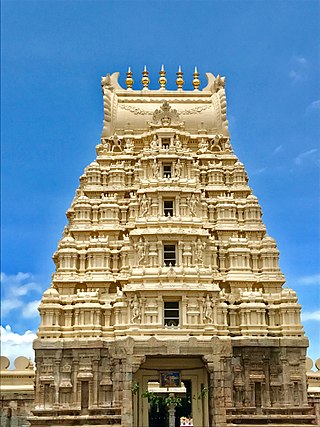
Srirangapatna or Srirangapattana is a town and headquarters of one of the seven Taluks of Mandya district, in the Indian State of Karnataka. It gets its name from the Ranganthaswamy temple consecrated around 984 CE. Later, under the British rule, the city was renamed to Seringapatam. Located near the city of Mandya, it is of religious, cultural and historic importance.

Kodagu district is an administrative district in the Karnataka state of India. Before 1956, it was an administratively separate Coorg State at which point it was merged into an enlarged Mysore State.

Bekal Fort is a medieval fort built by Shivappa Nayaka of Keladi in 1650 AD, at Bekal. It is the largest fort in Kerala, spreading over 40 acres (160,000 m2).
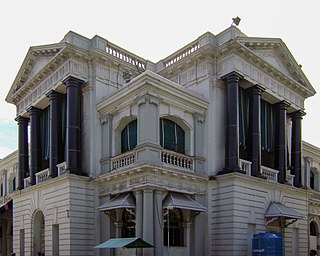
Fort St. George is a fortress at the coastal city of Chennai, India. Founded in 1639, it was the first English fortress in India. The construction of the fort provided the impetus for further settlements and trading activity, in what was originally an uninhabited land. Thus, it is a feasible contention to say that the city evolved around the fortress. The fort currently houses the Tamil Nadu legislative assembly and other official buildings.
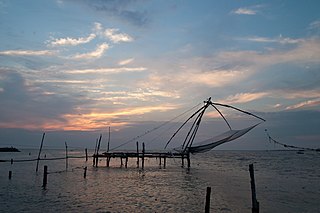
Fort Kochi, formerly known as Fort Cochin or British Cochin, is a region of Kochi city in Kerala, India. Fort Kochi takes its name from the Fort Manuel of Kochi, the first European fort on Indian soil, controlled by the Portuguese East Indies. This is part of a handful of water-bound islands and islets toward the south-west of the mainland Kochi, and collectively known as Old Kochi or West Kochi. Adjacent to this is the locality of Mattancherry. In 1967, these three municipalities along with a few adjoining areas, were amalgamated to form the Kochi Municipal Corporation.

The History of Karnataka goes back several millennia. Several great empires and dynasties have ruled over Karnataka and have contributed greatly to the history, culture and development of Karnataka as well as the entire Indian subcontinent. The Chindaka Nagas of central India Gangas, Rashtrakutas of Manyakheta, Chalukyas of Vengi, Yadava Dynasty of Devagiri were all of Kannada origin who later took to encouraging local languages.

Vellore Fort is a large 16th-century fort situated in heart of the Vellore city, in the state of Tamil Nadu, India built by the Emperors of Vijayanagara. The fort was at one time the imperial capital of the Aravidu Dynasty of the Vijayanagara Empire. The fort is known for its grand ramparts, wide moat and robust masonry.

Nalknad Palace or Nalkunadu, called Naalnaad Aramane in the local Kodava language, is a palace located in the Kodagu district of the Indian state of Karnataka. It is located near a village named Yavakapadi and was built between the years 1792 and 1794 AD. This palace was the last refuge of the last of the Haleri kings of Kodagu, Chikka Veerarajendra before he was deposed by the British. The Kannada film Shanti, which has only a single actor, was shot in the surroundings of the palace.

Bangalore Fort began in 1537 as a mud fort. The builder was Kempe Gowda I, a vassal of the Vijaynagar Empire and the founder of Bangalore. King Hyder Ali in 1761 replaced the mud fort with a stone fort and it was further improved by his son King Tipu Sultan in the late 18th century. It was damaged during an Anglo-Mysore war in 1791. It still remains a good example of 18th-century military fortification. The army of the British East India Company, led by Lord Cornwallis on 21 March 1791 captured the fort in the siege of Bangalore during the Third Mysore War (1790–1792). At the time the fort was a stronghold for King Tipu Sultan. Today, the fort's Delhi gate, on Krishnarajendra Road, and two bastions are the primary remains of the fort. A marble plaque commemorates the spot where the British breached fort's wall, leading to its capture. The old fort area also includes King Tipu Sultan's Summer Palace, and his armoury. The fort has provided the setting for the treasure hunt in the book Riddle of the Seventh Stone.
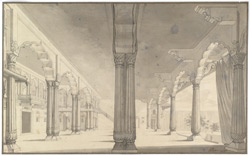
Tipu Sultan's (Summer Palace), in Bangalore, India, is an example of Indo-Islamic architecture and was the summer residence of the Mysorean ruler Tipu Sultan. Hyder Ali commenced its construction within the walls of the Bangalore Fort, and it was completed during the reign of King Tipu Sultan in 1791. After King Tipu Sultan died in the Fourth Anglo-Mysore War, the British Administration used the palace for its secretariat before moving to Attara Kacheri in 1868. Today the Archaeological Survey of India maintains the palace, which is located at the center of Old Bangalore near the Kalasipalya bus stand, as a tourist spot. Entry fee is ₹20 for Indian citizens, while for foreign visitors is ₹200 (US$2.30).

The siege of Bangalore was a siege of the town and fortifications of Bangalore during the Third Anglo-Mysore War by forces of the British East India Company, led by Charles, Earl Cornwallis against a Mysorean garrison, while Tipu Sultan, Mysore's ruler, harried the camps and positions of the besiegers. Arriving before the town on 5 February 1791, Cornwallis captured the town by assault on 7 February, and after six weeks of siege, stormed the fortress on 21 March.

Government Museum, Bengaluru, established in 1865 by the Mysore State with the guidance of Surgeon Edward Balfour who founded the museum in Madras and supported by the Chief Commissioner of Mysore, L.B. Bowring, is one of the oldest museums in India and the second oldest museum in South India. It is now an archaeological museum and has a rare collection of archaeological and geological artifacts including old jewellery, sculpture, coins and inscriptions. The museum is also home to the Halmidi inscription, the earliest Kannada inscription.
The Karnataka Central Diocese is one of the twenty-two dioceses of the Church of South India covering the central part of Karnataka. The Church of South India is a United Protestant denomination.
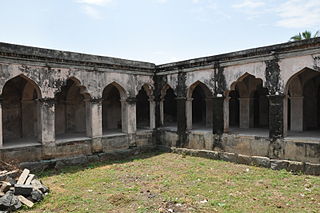
Attur Fort is a historic fort present in Attur in Salem district in the South Indian state of Tamil Nadu. The fort is located on the banks of river Vashista, 56 km (35 mi) away from Salem.The fort was built by a Palaiyakkarar chieftain Gatti Mudaliar dynasty under Madurai Nayaks, called Lakshmana Nayakan during the 17th century.

Srirangapatna Fort is a historical fort located in Srirangapatna, the historical capital city of the Kingdom of Mysore in present-day South Indian state of Karnataka. Built by the Timmanna Nayaka in 1454, the fort was modified by King Haider Ali & King Tipu Sultan and fully fortified in the late 18th century with the help of French architects. King Tipu Sultan wanted to protect it against British invaders associated with the East India Company.

The St. Mark's Church, is located within the Mercara Fort, Coorg, India and was raised in 1859, by the officers and men of the East India Company. The church building was funded by the Government of Madras, and placed under the Church of England in India, Diocese of Madras. The Church was closed after Indian independence, and taken over by the Government of Karnataka in 1971. The building now houses the Madikeri Fort Museum, managed by the Karnataka State Archaeological Department.

Masjid-i-Ala is a mosque located inside the Srirangapatna Fort in Srirangapatna in Mandya District in Karnataka. It was built in 1786–87, during the rule of Tipu Sultan.
Dodda Vira Rajendra was the ruler of the Kingdom of Coorg from 1780 to 1809. He is considered a hero of Coorg history for having freed the kingdom from the occupation of Tipu Sultan, the king of Mysore. He later aided the British in their fight against Tipu Sultan.Dodda Veera raja constructed the city of Virarajendrapete, today known as Virajapet, he also built a street called Mahadevpet in Madikeri town























